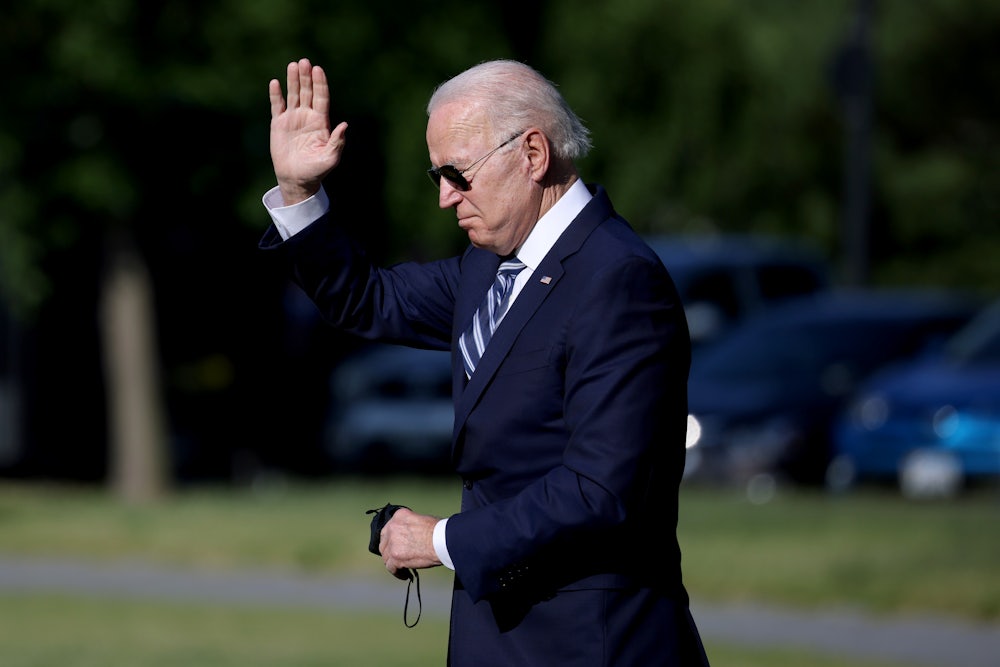It didn’t garner any “Dems in Disarray” headlines, but an important fault line emerged in April as Democratic leaders put forward dueling legislative proposals. As the country waited to find out the details of President Biden’s American Families Plan infrastructure package, which he had promised would include serious investments in the country’s childcare system, lawmakers jockeyed to influence his thinking.
On April 22, Senator Patty Murray and Representative Bobby Scott reintroduced their Child Care for Working Families Act. A mere five days later, Senator Elizabeth Warren and Representative Mondaire Jones reintroduced their own, different vision, the Universal Child Care and Early Learning Act. The press releases made no mention of each other. “As we work to build back a stronger, fairer economy, we must recognize that investment in child care is essential—and that’s exactly what Child Care for Working Families does,” Murray said in her release. “Our legislation will ensure every working family can get high-quality, affordable child care, and that our child care educators are paid what they deserve.”
“We must invest $700 billion to fix our broken child care system and ensure that women and families are not left behind in our recovery,” Warren countered in hers. “Our legislation would guarantee all parents affordable access to safe and nurturing child care and early learning opportunities for their kids.”
They don’t sound much like fighting words until you read between the lines and examine each proposal side by side. We’re at a pivotal moment in this country when it comes to childcare policy. Both parties recognize that it costs too much. Democrats agree that the government should spend a lot more money to make sure parents can put their children in high-quality settings that they can afford. But the camaraderie quickly fizzles once you get into the dirty work of deciding how to accomplish that goal. It’s vital that Democrats are finally unafraid to spend money helping families secure and afford good quality care for their children. But, as always, the devil is in the detail.
Murray and Scott’s legislation is by no means a universal childcare bill. It would invest money in creating more preschool programs for three- and four-year-olds, improving quality at childcare providers, and increasing wages for staff. When it comes to helping parents afford the high cost, it gets pretty convoluted. Families earning less than 75 percent of their state’s median income would have their childcare costs fully subsidized, while those making between 75 percent and 150 percent of their state’s median income would have their expenses capped at 7 percent of their income. Without grabbing a computer or smart phone, do you have any idea whether you would qualify or for how much? Can you guess your state’s median income? Me neither.
Warren and Jones’s approach is very different. Families earning twice the federal poverty rate or less would pay nothing for childcare. All families above that level would have their costs capped at 7 percent, rich or poor. There is one question to answer: Are you living in or near poverty or not? No matter the answer, you are owed help from the government. It also ensures more access by getting the government directly involved in the business of providing childcare—creating a federally funded, locally run network of public childcare centers that would follow Head Start–like quality standards, not just ensuring parents have more options but also goading private providers to raise the bar.
Senator Bernie Sanders also proposed a national universal childcare and preschool program when he ran for president, but his went even further, guaranteeing free care to every American family. “In the richest country in the history of the world, we have a moral responsibility as a nation to guarantee high-quality care and education for every single child, regardless of background or family income,” he argued at the time. His plan would have tied quality improvements to receiving federal money and spent funds on constructing and renovating childcare facilities to increase capacity.
Warren, along with a handful of other senators, including Sanders himself and dozens of House representatives, sent Biden a letter urging him to spend $700 billion on a universal childcare proposal much like this in the American Families Plan. “We believe this is a generational opportunity to invest in affordable, quality care for all children who need it,” they wrote, “and we urge you not to let it go to waste.”
And yet Murray and Scott’s approach has so far won out. Not only did their legislation garner supportive quotes from party leaders Chuck Schumer and Nancy Pelosi, it clearly created the framework Biden ended up adopting for his own plan. His version is nearly identical, although missing many details: The “most hard-pressed” families would pay nothing, but it only caps costs at 7 percent of income for those earning up to 1.5 times their state’s median; better-off families wouldn’t get assistance. It spends $225 billion over a decade, a third of what Warren and her colleagues have put forward.
But there are important advantages to the Warren and Jones approach. First, of course, is its simplicity. That’s not just a nice thing to have. There are costs to means-tested programs. One is administrative: It takes a lot more paperwork and manpower to guide people through a maze of red tape and determine who is deserving of government aid and who isn’t. That requires government resources but also time and effort from people who want and need the assistance. Sometimes it’s too high a barrier to clear, and those who are eligible still don’t get enrolled.
There’s also the political advantage. Universal programs have been found to enjoy more stability. When everyone participates, everyone has a stake in a program’s future. It’s also hard to tar it as welfare or a handout if rich people get it, too.
It’s also the right approach for a problem like childcare. All of the pieces of a childcare system hang on each other. If you just pump more money into it via parents’ pockets, for instance, you aren’t likely to significantly address the question of supply, or quality. Half of Americans have no available childcare slots in their area. Where are they going to spend their extra subsidies? Murray and Scott try to address the problem of quality by tying their money to higher standards, but those will have to be somehow enforced.
Warren and Jones’s plan, on the other hand, offers a public option and therefore direct competition, raising the standard of quality while also offering existing providers money to keep pace. They get the government directly involved in the business of creating more childcare supply. Even Warren’s plan could fall short of truly transforming the system if local governments don’t take up the federal government’s financial offer to create these new centers and the crises of supply and quality don’t budge. But it at least stands a chance of creating what could rightly be called an actual American childcare system: one where parents have high-quality options for their children that they can actually afford.
The question of whether to offer universal support or to means-test government help is not something the party is only wrestling with when it comes to childcare. It reared its head during the presidential contest when Democratic candidates sparred over whether to make public college free for everyone or target college aid only at the most needy. It’s in the background when the party debates whether to back a universal health care system, perhaps Medicare for All, or to stand instead for offering subsidies to Americans who most need them. The historic expansion of the child tax credit for a year reaches nearly every family—but not every family, so it’s still not quite a universal child allowance.
It seems that the party is still listening to its old instincts of cutting portions of the population out of its exciting new programs and narrowing its vision of what the government can do. But much is in flux as Congress gets down to the task of actually passing new legislation. The party can still aim for the universal; it can still raise its ambitions.








